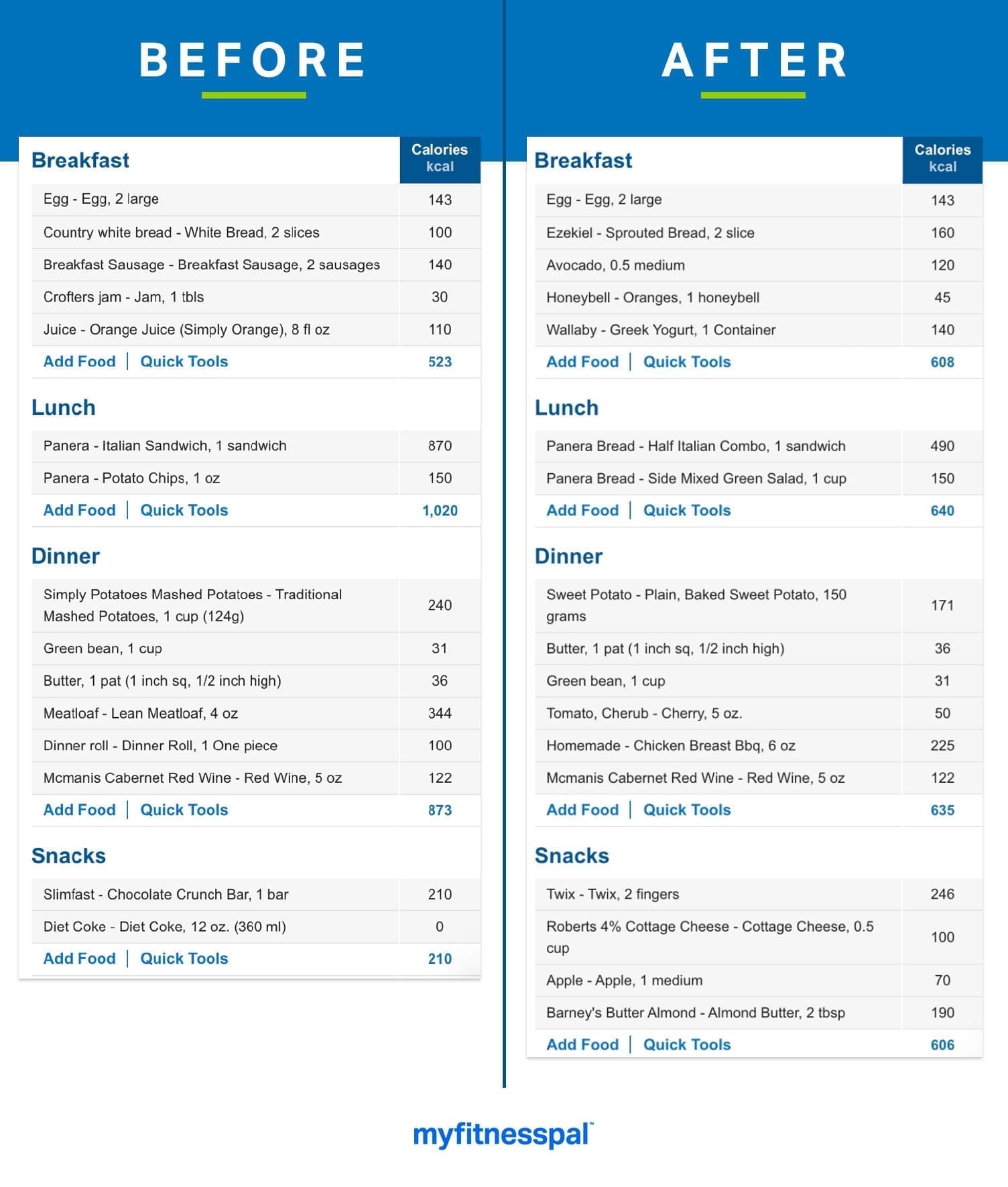Many people adhere to specific diets and track food intake to meet a particular calorie count. While calories are a large part of the weight equation, they are just part of what makes up a healthy, fit lifestyle. Food is more than calories, it is macro- and micronutrients, enjoyment, satisfaction, hunger, goals, nourishment, energizing, replenishing and so much more.
To have a diet that works for your goals and is one you can stick to for a long time, make sure it satisfies more than calorie counts. With a little food-savvy, you can choose options that are better for your body for equal, or even lower, calorie amounts.
Let’s take a look at two food intakes and discuss why the second choice is a better option.

BREAKFAST: ADD FIBER AND MICRONUTRIENTS
While the “before” option is a pretty typical American breakfast and offers all three macros (protein, fat, carbohydrates), it lacks micronutrients and fiber which could have you feeling sluggish early in the day. Breakfast sausage is highly processed as is the orange juice.
The “after” option, on the other hand, substitutes avocado and Greek yogurt for the breakfast sausage and an actual orange instead of orange juice. Plus, instead of white toast, the two slices of sprouted toast elevate the fiber content. The slight calorie increase offers a more nutrient-dense meal.
LUNCH: WATCH PORTIONS AND MAKE HEALTHY SUBSTITUTIONS
A good lunch should perk you up to get through the remainder of the workday — and nothing is worse than returning from a lunch break feeling heavy and bloated or being upset about making bad choices. Making small adjustments, like watching portion sizes, goes a long way.
For example, a large Panera sandwich on a roll stuffed with processed meats and cheese paired with greasy chips is likely to make you feel full, but not in a good way. You can compromise without drastically changing your intake by opting for half the sandwich and pairing it with a green salad. This way, you can lighten the caloric load and provide your body with more fiber, vitamins and minerals.
DINNER: BEWARE PROCESSED FOODS
There isn’t anything ‘wrong’ with the before option, but it could be better. Repeating the breakfast lesson of going for fewer processed and more nutrient-dense foods for this typical American dinner is a secret weapon. Swapping processed meats like loaves and sausages with cleaner choices such as fish, chicken or a steak provides more protein and fewer calories. Same with mashed potatoes, try to nix mix-dishes and choose the single-ingredient food instead. That’s why option 2 is the better choice. By subbing in sweet potatoes and chicken breast for mashed potatoes and meatloaf, you’ll get higher-quality food choices and more balanced combinations of protein, fat and carbohydrates.
SNACKS: TREAT YOURSELF TO THE REAL THING
You probably think this is a mistake, that the options got messed up, but they didn’t. We trick ourselves into thinking food items labeled as ‘healthful’ or part of a diet are the better options. But who really enjoys eating that chalky ‘diet’ food, especially when you’re only saving 36 calories? Skip it and treat yourself to the real thing in moderation. You will appreciate eating it more, so long as you do it mindfully, and you’ll come to have a better relationship with your food intake.
THE BOTTOM LINE
Overall, the calories between the two options are close. Still, the rehabbed option more evenly spreads calories and nutrients throughout the day, helping you control your appetite and energy levels without feeling sluggishly full nor too hungry. This comparison should provide insight that diet shifts do not need to be drastic to be beneficial and that a healthy food intake needs more thought than merely hitting calorie numbers.
Make progress on nutrition and fitness goals with our “Plans” feature in the MyFitnessPal app for daily coaching and easy-to-follow tasks.




